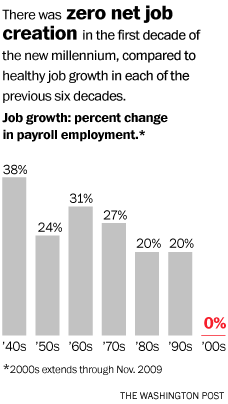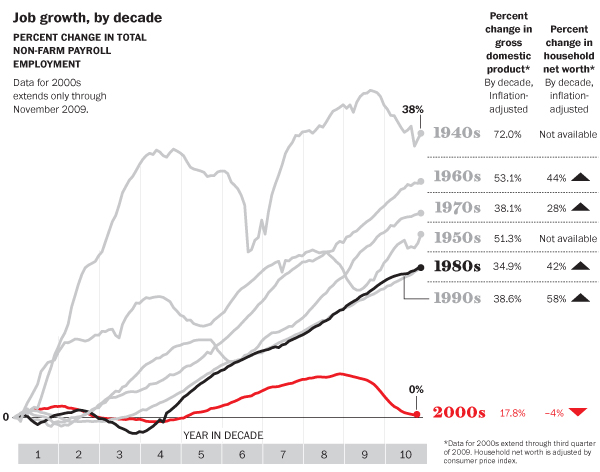The private-sector job growth in the last decade was non-existent. I discussed this issue last August here. More recently Neil Irwin of Washington Post wrote about the lack of private-sector job growth in the last decade in a piece titled Aughts were a lost decade for U.S. economy, workers.
Charts:
Source: Washington Post
During the past decade, the US economy experienced a credit crisis and the collapse of the dot com bubble. Millions of workers lost their jobs as a result these events. The unemployment rate stood at 10% in December and there were 15.3 million Americans out of work. About one million Americans fell out of the civilian labor force in December as they were categorized as “long-term discouraged”. The actual rate as measured by U6 unemployment is nearly 17%.
One of the unintended consequences of high unemployment is the impact on the social security system. The program was established in 1935 by the Social Security Act under the Roosevelt Administration. It provides benefits to many retired individuals and families. In a pure capitalistic system, social security would not exist. But after seeing the social ills of the Great Depression the American society changed and hence the social security system was established to offer some form of social safety net to retired people, disabled people and others.
How is the Social Security System Financed?
Social Security is a pay-as-you earn system in which current workers pay taxes for paying benefits to current benefit recipients. In 2008, the Old-Age and Survivors Insurance and Disability Insurance Trust Funds collected $805.3 billion in revenues. 83% of this revenue came from payroll taxes, 2% from income taxes on social security benefit payments and the remaining in 14% from interest earned on the assets held by the funds. The trust fund primarily invests in government bonds. The chart below shows that the majority of the revenue collected goes toward benefit payments with just 5% going into the trust fund after the deduction of 1% for administrative expenses.
How will the high unemployment rate and low (or) no job growth affect social security?
The social system may not survive in its current form in the long run unless changes are made to the tax structure and the benefits payment structure. Otherwise the system may need a bailout of its own in the future. The following are some of the reasons I believe that the social security program is headed towards a crisis. Of course any positive change in the economy such as strong job growth and rising income levels will shore up the social security fund.
1. Increasing number of retired people depend on social security now more than ever before:
In 1962 social security accounted for just 30% of the aggregate income of retired folks. In 2007 it amounted to 36% of aggregate income. This shows that despite many decades of economic growth and the rise in equity markets, senior citizens depended more on social security in 2007 than before. With the fall in the balance of 401K and other retirement accounts, home values, negligent interest earned on bank deposits, etc. in the past few years, a higher number of retired people will depend on social security in the coming years.
To put this in perspective, in 2007 nearly 56 million people received benefit payments. It provided at least half the income of 64% of seniors. With the 78 million baby boomers, the number of retirees will double in less than 30 years from 2008.
2. Social Security Trust Fund size may diminish:
In 2008, the fund collected $805 B in revenues and the outgo was $625B. The trust held $2.4Trillion. With the rising number of benefit seekers and reduced number of workers contributing into the fund, the total trust assets would shrink at a faster rate over the years.
Another factor is many of the high-paying jobs that have been off-shored may never come back due to the cheap labor available overseas. Even when jobs are created here they may be filled with cheaper labor from foreign countries. These workers may not be paid as much as the prevailing market rate and hence they will contribute less to the social security fund. A case in point is the popular H1B visa program which allows foreign skilled workers into the country on a temporary basis. The cap of 65,000 for fiscal year 2010 has already been reached. Hundreds of thousands of foreign workers who work in the service sector also will contribute less to the fund. There is even the problem of some of these immigrants getting paid under the table thereby contributing nothing to the social security fund. Due to these reasons the trustees may have to sell assets to pay recipients.
An update:Â
Another factor that will negatively affect social security fund is that many of the unemployed workers will earn less than they did before when they re-enter the workforce. They will also contribute less to the social security fund. A New York Times article yesterday mentioned that unemployed workers may be forced to take on new jobs at reduced wages. The following quote from the article drives home the point:
“John Irons, research and policy director for the Economic Policy Institute in Washington, says that as millions of unemployed workers accept lower pay for new jobs, their collective wage cuts will likely stifle income growth for years.”
3. People live longer:
More people are living longer due to advances in medical technology. As they live longer they draw more benefits from social security.
4. Ratio of workers to recipients is getting low:
In 2008 the ratio of current workers to benefit recipients was at 3.2 to 1. By 2034, this ratio is projected to reach 2.1 to 1. This implies that just over 2 persons will be available to pay into the fund to help each recipient’s benefits. The 2009 Trustees Report projects that by 2016, when the ratio reaches 2.8 to 1, there will not be enough workers to pay recipients at the current tax rate.
Since the 1950s the ratio has been falling at an alarming rate.
Another way to analyze this point is review the Employment to Population ratio.
This ratio shows the number of employed individuals to the the total population. Calculated Risk put out a interesting chart showing the decline in this ratio. CR noted “The Employment-Population ratio continues to plunge, falling to 58.2% in December – the lowest level since 1983.”The Labor Force Participation Ratio fell to 64% in December. The total number of employed in the civilian labor force last month was 137M.
If trust funds were to be liquidated to pay for benefit recipients, there will be enough funds till 2037.
The long-run financial outlook for social security:
At the current benefit and tax rates the social security system is not sustainable over the long-term. By 2016, the program will pay out more in benefits than it collects.
“By 2037 the trust funds will be exhausted. At that point, payroll taxes and other income will flow into the fund but will be sufficient to pay only 76% of program costs. As reported in the 2009 Trustees Report, the shortfall over the next 75 years is 2.00% of taxable payroll.”
Source: Fast Facts & Figures About Social Security, 2009
From the above analysis it is clear that the Social Security system in this country needs to be completely restructured to match the current population, job growth and economic trends. It will take serious political will and input from all stakeholders in order to solve the issues surrounding this highly important benefit program offered by Uncle Sam.





